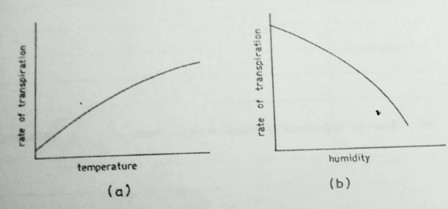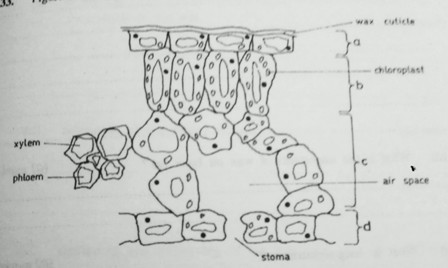PAPER 1
THEORY
SECTION A
1. The following are conditions necessary for germination except
A. Oxygen.
B. Moisture.
C. Moderate temperature.
D. Carbon dioxide.
2. The main value of panting in a dog is that
A. Excess water is removed from the body.
B. Latent heat of vaporization of water cools the body.
C. Excess mineral salts are removed from the body.
D. The dog relaxes from exhaustion.
3. Which one of the following is true about a person of blood group O?
A. Receives blood from people of all other blood groups.
B. Donates blood to people of all other blood groups.
C. Receives blood from only people of blood groups AB and O.
D. Donates blood to only people of blood group AB.
4. The main value of sweating in man is that during the process
A. Excess water is lost.
B. Excess salts are got rid of.
C. The body is cooled.
D. Excess nitrogenous waste is got rid of.
5. Sexual reproduction in spirogyra is described as
A. Fragmentation.
B. Conjugation.
C. Binary fission.
D. Budding.
6. Lack of a nucleus in a red blood cell is advantageous in that it
A. Enables the cell to pass through thin epithelium.
B. Helps the cell to fight diseases-causing organisms.
C. Allows the cell to carry a lot of oxygen.
D. Enables the cell to carry much dissolved food.
7. Which of the following parts of a flower is not essential for reproduction?
A. Corolla.
B. Stigma.
C. Style.
D. Anther.
8. Mitosis is different from meiosis in that mitosis results into
A. Four daughter cells with equal genetic matter.
B. Two daughter cells with equal genetic matter.
C. Four daughter cells with half the genetic matter.
D. Two daughter cells with half the genetic matter.
9. The role of rennin in children during digestion is
A. Breaking down milk protein into peptides.
B. Mixing the milk protein with digestive enzyme.
C. Activating pepsin to digest the milk protein.
D. Coagulating milk protein.
10. Which one of the following is a reaction to over-cooling by a mammalian body?
A. Dilation of blood vessels.
B. Sweating.
C. Decrease in metabolic rate.
D. Shivering.
11. A good mammalian respiratory surface should be
A. Dry with large surface area.
B. Moist with reduced surface area.
C. Dry with many blood vessels.
D. Moist with many blood vessels.
12. Which of the following parts of a plant cell provides shape and rigidity?
A. Protoplasm.
B. Nucleus.
C. Cell wall.
D. Cell membrane.
13. Which one of the following is not a function of the liver?
A. Regulation of blood sugar.
B. Production of insulin.
C. Formation of bile.
D. Storage of iron.
14. Which of the following biological processes describes a fungus growing on the leaves of a living potato plant?
A. Predation.
B. Parasitism.
C. Competition.
D. Saprophytism.
15. In cattle, when a white bull is mated a red cow, the offspring is roan. This indicates that the gene for white is
A. Dominant to that for red.
B. Recessive to that for red.
C. Co dominant with that for red.
D. Mutated to show roan.
16. What would be the ratio of the phenotypes if a roan bull and roan cow from the offspring referred to in question 15 were mated?
A. 1 red: 2 roan: 1 white.
B. 2 red: 1 roan: 1 white.
C. 1 red: 1 roan: 2 white.
D. 1 red: 1 white.
17. Which one of the following is true about insect pollinated flowers?
A. Produce small and smooth pollen.
B. Have small greenish bracts.
C. Stigma and pollen are often sticky.
D. Filaments are flexible and anthers loosely attached.
18. While analyzing a soil sample, the following results were obtained:
Sand = 200 cm3
Water = 300 cm3
Water and sand after stirring = 450 cm3
What was the percentage of air in the sand?
A. 10 %.
B. 20 %.
C. 25 %.
D. 30 %.
19. Which of the following features of an amphibian are suited for aquatic life?
A. Possession of wings.
B. Muscular hind limbs.
C. Moist skin without scales.
D. Webbed toes.
20. Which part of Irish potato plant is used in its vegetative reproduction?
A. Stem.
B. Root.
C. Leaf.
D. Flower.
21. In which two parts of the alimentary canal is starch digested?
A. Small intestines and mouth.
B. Mouth and duodenum.
C. Duodenum and stomach.
D. Mouth and stomach.
22. Lack of iodine in the human diet causes
A. Anaemia.
B. Scurvy.
C. Goiter.
D. Rickets.
23. Which of the following farming practices would control soil erosion?
A. Application of artificial fertilizers.
B. Addition of compost manure.
C. Terracing.
D. Mixed farming.
24. Which one of the following maintains a transpiration stream in flowering plants?
A. Capillarity.
B. Osmosis.
C. Diffusion.
D. Active transport.
25. Which one of the following layers of the human skin helps the body to retain water?
A. Granular layer.
B. Malpighian layer.
C. Subcutaneous layer.
D. Confide layer.
26. Which one of the following is not caused by oestrogen?
A. Healing of the uterine wall.
B. Growth of the uterine wall.
C. Inhibiting further secretions of follicle stimulating hormone.
D. Causing ovulation.
27. Which one of the following increases the amount of nitrogen in the atmosphere?
A. Excretion.
B. Action of fungi on dead organic matter.
C. Action of nitrifying bacteria.
D. Action of denitrifying bacteria.
28. The following are structures of a cell.
(i) Cell wall.
(ii) Cell membrane.
(iii) Nucleus.
(iv) Chloroplast.
Which of them are found in both plant and animal cells?
A. (i), (ii) and (iv).
B. (i), (ii) and (iv).
C. (ii) and (iii).
D. (ii) and (iv).
29. Which one of the following parts of a tooth contains living tissue?
A. Cement.
B. Pulp' cavity.
C. Enamel.
D. Dentine.
30. Which one of the following occurs during exhalation in a mammal?
A. The diaphragm relaxes.
B. The inter-coastal muscles contract.
C. The volume of the chest cavity increases.
D. The ribs move upwards and outwards.
SECTION B
Answer all questions in this section. Answer must be written in the spaces provided.
31. a) What is 'transpiration'?
b) Figures 1 (a) and (b) show how temperature and humidity affect the rate of transpiration.

(i) From fig. 1(a), describe how the rate of transpiration changes with temperature.
(ii) From fig. 1(b), describe how the rate of transpiration changes with humidity.
c) Explain why:
(i) Temperature affects the rate of transpiration as shown in figure 1(a)
(ii) Humidity affects the rate of transpiration as shown in figure 1(b).
d) State the importance of transpiration in plants.
32. How does each of the following characteristics of a respiratory surface aid diffusion of gases at the surface?
a) Thin epithelium.
b) Dense network of capillaries.
c) Moist surface
d) Large surface area.
33. Figure 2 shows an internal structure of a leaf.

a) Labe the layers marked a, b, c and d on the diagram.
b) Give three differences between layers b and c.
| Layer b | Layer c |
|
(i) ........................ (ii) ....................... (iii) ...................... |
...................... ...................... ...................... |
c) Using evidence from the diagram, describe how the structure of a leaf is suited for photosynthesis.
d) What is the importance of wax on layer (a)?
34. a) What is long - sightedness?
b) State two causes of long - sightedness.
(i) ...............................................................................................................
(ii) ..............................................................................................................
c) In the space below, draw light rays from an object into the eye to show long sightedness.
d) What is the effect of each of the following movements of the different parts of the eye?
(i) Contraction of the iris.
(ii) Relaxation of the cilliary muscle.
(iii) Shortening and thickening of the lens.
SECTION C
Answer any two questions.
35. a) Distinguish between dominance and co dominance in genetics.
b) When tall pea plants were crossed with short pea plants, all the plants in F1 generation were tall. When two plants of the F1 generation were crossed, both tall and short plants were produced in the F2 generation.
(i) Why were all plants tall in the F1 generation?
(ii) Using suitable symbols show the crosses to produce the F1 and F2 generations.
c) In rose plants, when a red flowered plant crossed with a white flowered plant, all plants produced bear pink flowers. Using suitable symbols show the result of crossing a pink flowered plant and a white flowered plant.
36. a) What do you understand by environmental degradation?
b) Describe how man's activates lead to the degradation of soil.
37. a) List the substances transported by the blood circulatory system.
b) Give the importance of transporting each one of the substances named in (a) above.
38. a) What is excretion?
b) With the aid of a labelled diagram describe the functioning of the kidney in excretion.
